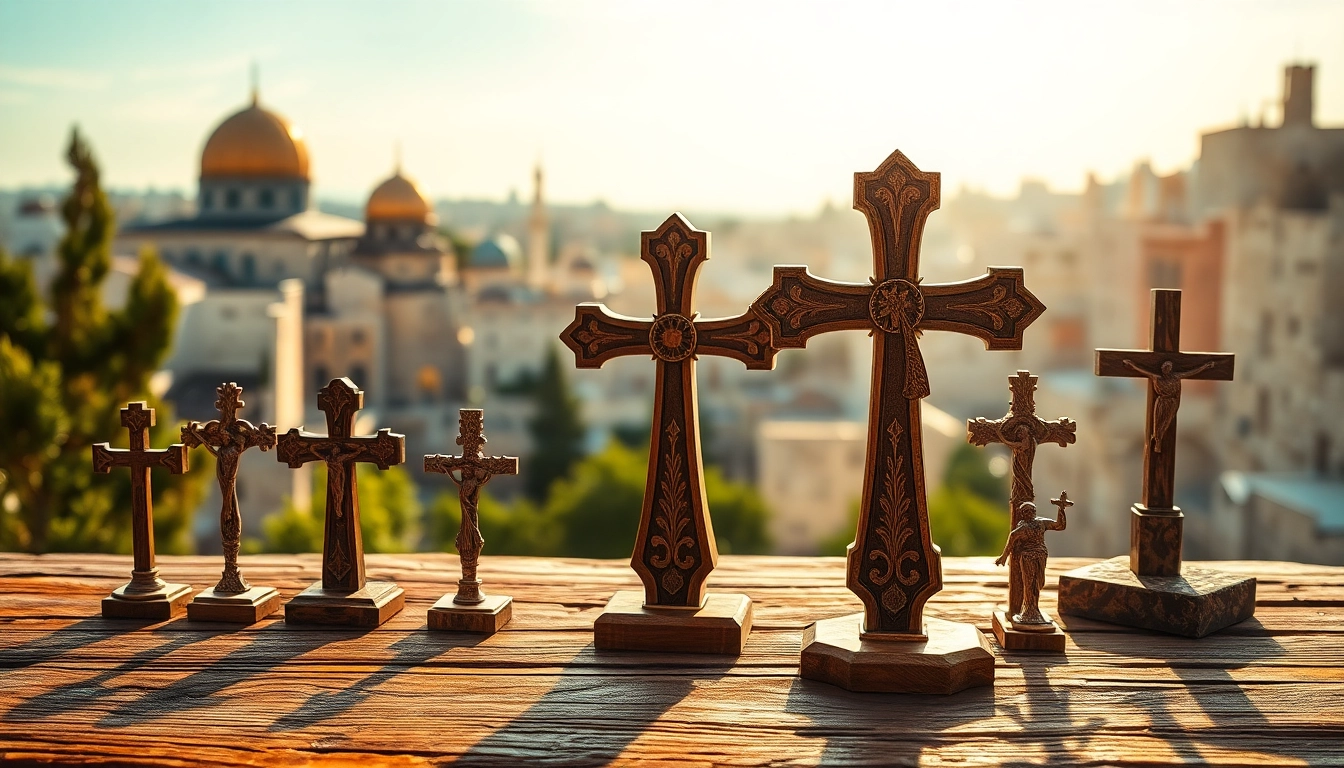The Origins of Jerusalem Crosses
Historical Context
The Jerusalem cross, often referred to as the “Crusader’s Cross,” has deep roots in Christian history. Its design features a large cross potent at the center, encircled by four smaller Greek crosses—one in each quadrant. This emblem can be traced back to the time of the Crusades, specifically during the 11th century, when it became a recognized symbol of the Kingdom of Jerusalem. This symbol was not merely a representation of faith but also a political emblem, emphasizing the power and reach of the crusaders at that time.
As the crusaders established their presence in the Holy Land, they sought to blend their beliefs with local customs and décors. The design encapsulated the teachings of Jesus Christ and the importance of spreading the gospel, aligning with the historical movement of Christians re-establishing their connection to Jerusalem, the heart of their faith. Jerusalem crosses not only served as religious tokens but also functioned as markers of territorial and cultural identities.
Symbolic Meanings
The symbolism of the Jerusalem cross is multifaceted. Each of the four smaller crosses represents one of the Four Evangelists—Matthew, Mark, Luke, and John—whose teachings are fundamental to Christianity. Additionally, they symbolize the four corners of the Earth, indicating the spread of Christianity throughout the world.
Some interpretations suggest that the larger cross signifies Jesus Christ and his pivotal role in Christianity, while the four smaller crosses emphasize the mission to evangelize and disseminate his teachings to all nations. The Jerusalem cross has been adopted by various Christian denominations and remains a potent symbol among many contemporary Christian movements.
Evolution Over Time
Over the centuries, the Jerusalem cross has evolved in both style and meaning. While its origin aligns with the crusading order, it has also been embraced by different Christian communities across the globe. Its symbolism has been reassessed through historical events, artistic interpretations, and cultural exchanges that highlight the resilience of faith through adversity.
During the Renaissance, for example, the Jerusalem cross appeared in various works of art and architecture, signifying a renewed interest in religious symbols as patrons sought to infuse their creations with deeper meaning and significance. As globalization has taken root, the cross has emerged as a universal symbol of peace and faith across Christian factions, often interpreted in various artistic styles that reflect local cultures.
Different Styles of Jerusalem Crosses
Materials Used
The construction of Jerusalem crosses varies significantly, often reflecting the resources available and the craftsmanship of the region. Traditional styles may be carved from olive wood, which is abundant in the Holy Land and carries its own symbolism of peace and endurance. Olive wood crosses are often hand-carved, showcasing exquisite craftsmanship, and are popular among pilgrims visiting Jerusalem.
Moreover, Jerusalem crosses can also be made from a variety of metals including gold, silver, and bronze, which are often adorned with gemstones or unique engravings. Each material contributes to the cross’s final aesthetic and spiritual interpretation, further enriching its historical narrative.
Design Variations
The design of the Jerusalem cross can differ widely depending on the cultural context and artistic vision of the maker. While the traditional form remains standard—one large cross surrounded by four smaller crosses—variations can include different motifs, embellishments, and styles that showcase the artist’s unique approach.
Modern adaptations might simplify the design or elaborate it with intricate patterns and oxidization processes to evoke certain themes or aesthetics. For instance, contemporary artists often incorporate additional elements or stylizations that resonate with their cultural identity, making each piece unique while still honoring its origin.
Crosses in Modern Art
In recent years, the Jerusalem cross has also found its place in modern artistic expressions, appearing in paintings, sculptures, and installations around the world. Contemporary artists often reinterpret traditional motifs, incorporating modern styles and colors while communicating themes of faith, resilience, and unity.
One notable example is the use of the Jerusalem cross in mixed media art that combines traditional materials with digital media, enabling the creation of hybrid artworks that engage with contemporary viewers. These innovations not only keep the legacy of the cross alive but also broaden its appeal to younger generations who may find traditional forms less relatable.
The Cultural Impact of Jerusalem Crosses
Religious Significance
Beyond its historical context, the Jerusalem cross bears significant weight within religious practices and beliefs. For Christians, it represents the faith’s core message of hope and redemption, echoing throughout liturgical ceremonies and celebrations. The cross is particularly revered during religious observances and events such as Easter and Christmas, symbolizing the death and resurrection of Christ.
In certain Christian communities, the Jerusalem cross has also become a symbol of pilgrimage, marking the journey undertaken by faithful adherents wishing to connect with their religious heritage by visiting the sites of Christ’s life and early church.
Inclusion in Ceremonies
Jerusalem crosses frequently feature in various ceremonies, from baptisms and confirmations to weddings and ordinations. Their presence adds a layer of sanctity to these milestones, enhancing the spiritual significance of the events. The cross may be worn by individuals as jewelry or incorporated into altar decorations and church regalia, stressing its ongoing relevance within communal worship.
Moreover, in some communities, it is customary to give Jerusalem crosses as gifts during significant life events, a gesture meant to bless and protect the wearer while symbolizing the giver’s heartfelt wishes. This practice of gifting, rooted in tradition, helps perpetuate the cultural and religious significance of the cross across generations.
Representation in the Arts
The Jerusalem cross’s influence extends into literature, film, and music, where it often serves as a potent symbol embodying themes of faith, identity, and destiny. Its representation can evoke various emotional responses, challenging audiences to reflect on their values and belief systems.
In literature, characters adorned with or confronting the symbol may navigate moral dilemmas or transformative journeys, prompting introspection about their faith journeys. Similarly, films featuring the Jerusalem cross often explore the complexities of religious identity and community, framing the narrative within historical or cultural contexts that allow deeper engagement with these themes.
How to Choose the Right Jerusalem Cross
Factors to Consider
When choosing a Jerusalem cross, several factors should be taken into account. First, consider the material used in the creation process—different materials not only affect aesthetics but also longevity and how the cross will be perceived culturally. Wooden crosses evoke nature and simplicity, while metal crosses can signal strength and permanence.
Next, think about the design elements that resonate most with you. Each artist’s interpretation carries unique significance, so selecting a design that speaks to your personal beliefs or emotional connections will enhance the meaning of the cross for you or the intended recipient.
Authenticity and Craftsmanship
Authenticity is paramount when selecting a Jerusalem cross, especially if your intention is to acquire a piece that reflects true cultural heritage. Seek out reputable artisans or traders known for their craftsmanship and quality of materials used in their creations. Look for crosses that are handcrafted rather than mass-produced, as these often carry a richer story and deeper connection to the artist’s intent.
Consider asking about the origins of the piece, including where and how it was made. This information adds layers of meaning to the cross, connecting it with the historical narrative of Jerusalem and the cultural practices that surround its crafting.
Gift Ideas Featuring Jerusalem Crosses
The personal nature of a Jerusalem cross makes it a thoughtful gift for various occasions. For weddings, consider a beautifully designed cross as a wedding gift which symbolizes the union under the guidance of faith. In the event of a baptism or confirmation, giving a Jerusalem cross serves as a cherished keepsake representing the individual’s spiritual journey.
Additionally, incorporating the cross into personalized items such as wall art, jewelry, or decorative pieces can be a unique way to honor loved ones while reminiscing about the ideology encompassed in the symbol. These creations can serve as daily reminders of faith and connection to one’s heritage.
Caring for Your Jerusalem Cross
Maintenance Tips
To preserve the integrity and beauty of your Jerusalem cross, proper maintenance is essential. If the cross is made from wood, regular dusting and the occasional application of wood oil may help maintain its luster and prevent cracking. Ensure it’s kept in a safe environment, away from extreme humidity or direct sunlight, which can cause materials to degrade.
For metal crosses, cleaning them with a soft cloth is advisable, avoiding harsh chemicals that could affect their surface. Regular inspections to detect any wear can help in addressing issues before they escalate, thus prolonging the life of the piece.
Display Suggestions
When it comes to displaying your Jerusalem cross, consider creating a dedicated space in your home where it can serve as a focal point of reflection and inspiration. This could be a small altar or decorative shelf where it can be complemented by other meaningful objects like candles, photographs, or religious texts.
Another option is incorporating the cross in family gatherings or during celebrations to create a deeper connection among loved ones, reinforcing its significance in a shared environment. Its presence in communal spaces can ignite conversations about faith and heritage, enhancing the collective understanding of its value.
Contextual Usage in Home Decor
Using Jerusalem crosses as part of your home decor provides an opportunity to blend aesthetics with spirituality. Whether it is hung prominently on a wall, displayed on a mantle, or used as a centerpiece for tables, these crosses can convey messages of faith and resilience, subtly transforming your living environment into a space of comfort and reflection.
Moreover, they can complement various design styles, from rustic traditional to chic contemporary, weaving layers of meaning into the overall aesthetic of your home. The choice to display a Jerusalem cross can lead to a daily reminder of one’s beliefs and inspire meaningful discussions when guests visit.



